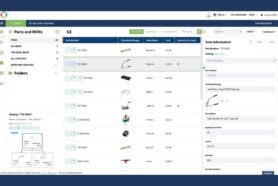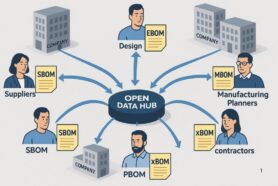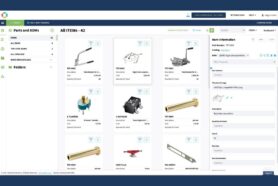
At OpenBOM we’re learning a lot from our prospects and customers. It is part of our product vision – to combine OpenBOM strategy with experience and things we learn from our customers. We believe this is the best way for us to build a successful product and service.
More than 450 reviews on G2 and customer stories are a confirmation of what we do. We learn every day from our customers and prospects. Check our article – 5 Things We Learned from OpenBOM Customers and Prospects in 2023. We keep these lessons in mind and look forward to continuing to provide innovative and user-centric data management solutions as part of the OpenBOM strategy.
A key part of this strategy is our focus on data. In the fast-paced world of engineering and manufacturing, data management and process optimization are essential for successful solutions to help engineering and manufacturing businesses. In this four-part blog series, I’d like to explore and highlight the various ways OpenBOM acts as your ultimate painkiller, tackling different aspects of data organization, management, and process enhancement.
Painkiller 1: Design Data, Organize, Manage & Capture
Every engineering and manufacturing company needs to manage a variety of data about the product they design, including CAD data, data needed for product planning and supply chain, assembly, and many other pieces of information. Everyone in engineering and manufacturing organizations needs data. But, from our experience, no one is really interested in spending the time on data management. While talking to many prospects, we realized that data organization is one of the biggest pains engineering and manufacturing teams are experiencing.
We learned that companies use common data management paradigms such as files and folders, using spreadsheets, and various customized databases. Then it turns into a data mess. OpenBOM helps engineering teams organize, manage, and capture design data efficiently. It gives you flexibility and peace of mind. Flexible data modeling combined with SaaS delivery model simplifies the complexity of design data, making it easier to access and work with throughout the product development lifecycle.
Painkiller 2: Agile New Product Development (PLM+ERP)
Every company is driven by processes involving multiple engineering and manufacturing teams, procurement, and supply chain management. To make these processes efficient, companies are looking at how to support them with the right data and helping to organize two things: (1) efficiency in process organization; (2) effectiveness in decision making.
It is hard to organize the process using disconnecting data sets, sharing data via emails, and fragmented cloud storage. The foundation of the OpenBOM New Product Development (NPD) process is an efficient information flow connecting the most important systems such as computer-aided design (CAD), product data management (PDM), product lifecycle management (PLM), and manufacturing and enterprise resource planning (MRP/ERP) features together. The result is a very efficient mechanism to support an entire set of data and activities starting from requirements and design phase moving towards production planning and sourcing.
OpenBOM enables agile new product development by bridging the gap between Product Lifecycle Management (PLM) and Enterprise Resource Planning (ERP) functions. For agile engineering teams to connect engineering and procurement information is extremely important. OpenBOM integration capabilities serve as a powerful painkiller, enhancing the collaboration between design and manufacturing teams for faster product development.
Painkiller 3: Collaboration (internal and external)
Collaboration is key in modern engineering and manufacturing. Modern products require multiple people to be involved in the complex process of design, engineering, planning, and procurement. All these activities require data sharing and communication. A typical PLM software is limited to a single organization and lacks flexibility in the way data can be shared. OpenBOM breaks the boundary by allowing data seamlessly captured and shared between individuals, teams, and organizations.
We’ll explore how OpenBOM fosters collaboration within and across organizations. Learn how OpenBOM acts as a catalyst for communication, ensuring that everyone is on the same page, regardless of their product design responsibility, location, or role in the process.
Painkiller 4: Flexible Data and Integration
Nothing in an engineering team or manufacturing company lives in isolation. Also, every company and team has a set of specific requirements to customize the information they need to manage. Engineers like Excel, because they can set them free from the complexity of data management. OpenBOM combines two things – the flexibility of the Excel paradigm and the powerful data management platform delivered via SaaS. It solves the problem of flexibility. The second part of the data management complexity is to integrate multiple applications that are already in use by the team or company – computer design tools (CAD), manufacturing planning, and financial tools. Seamless integration and open API allows OpenBOM to connect multiple data silos and processes together.
Discover how OpenBOM can seamlessly integrate with other tools and systems, providing a flexible approach to data management. Say goodbye to data silos and hello to a cohesive ecosystem.
Conclusion:
At OpenBOM we go beyond a traditional PLM paradigm. It focus on the most important elements of the new product development process (NPD) and connects users and data together. Throughout this four-part series, we’re going to explain how OpenBOM serves as the ultimate painkiller for engineering and manufacturing data organization and process streamlining. You will learn how OpenBOM helps you to organize a product life cycle. Whether it’s simplifying design data management, enabling agile product development, fostering collaboration, or offering flexible integration options, OpenBOM has you covered. You will get access to up-to-date information that ensures that such valuable engineering data, design and quality information, and other product-related data are always under control and shared with all members of your team, contractors, and suppliers.
REGISTER FOR FREE to learn how OpenBOM can help you organize design data, build the entire set of information about the product, and organize connected processes between engineering and production planning teams.
Best, Oleg
Join our newsletter to receive a weekly portion of news, articles, and tips about OpenBOM and our community.











